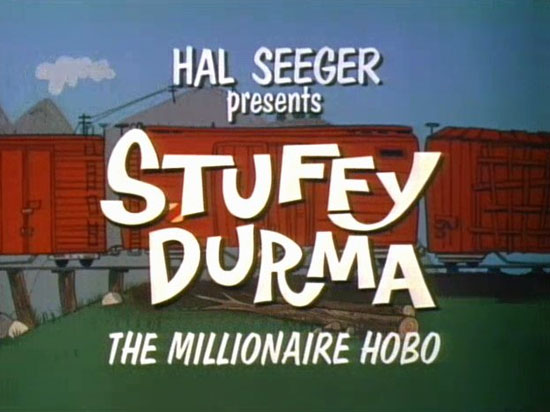
The animation scene in New York City during the early 1960s were either feast or famine, depending on your point of view – and your talents as an animator. Terrytoons and Max Fleischer’s studio (at this point known as Paramount Animation Studios) were shadows of their former selves – but there was much work to be had and several former Paramount animators, most notably Joe Oriolo and Hal Seeger, found great opportunity as producers in the burgeoning TV animation market.
Seeger didn’t have much of a chance competing with the Hollywood outfits with his budgets and production timelines. His Out Of The Inkwell Koko The Clown TV shorts were budgeted around $5,000 per five-minute cartoon, and the turnaround on the animation was something like a week. But “Shamus [Culhane], Myron [Waldman], then I started hiring real great writers, and we did a hell of a job on Milton The Monster,” Seeger told Jerry Beck and Will Friedwald in 1980. Or, in reality, “These are probably going to suck anyway, so let’s make them as weird as we possibly can.”
Thus, we have Milton The Monster, a fair representation of New York animation thinking; ideas and techniques are put into action that the Hollywood scene either wouldn’t dare do or think of. For 1965 TV animation, the success rate is of course going to vary wildly, but Seeger’s Milton at least has more visually and conceptually interesting vestiges than anything coming out of the Hollywood studios at the time (save DePatie-Freleng).
One undeniable joy of perusing the entire run of Milton The Monster is uncovering a quartet of Stuffy Durma cartoons animated by Jim Tyer and voiced by the brilliant Dayton Allen. The character was first conceived in 1953, as a back-up feature in Seeger’s short-lived comic book, Muggy Doo-Boy Cat. In the original strip – which spelled “Derma” with an “e“; drawn by animation story man Irv Spector – Stuffy is a hapless “Porky Pig” type. A supporting player without much else going for him.

The comics were a failure, but in subsequent years – whenever Seeger got the chance – he’d revive the characters. When a pilot Muggy-Doo cartoon (released theatrically by Paramount in 1963), faithful to the original comics, failed to catch on, Seeger simply revised the narratives. Thus, his “Boy Cat” was re-christened a “Boy Fox” and placed as a back-up feature on the Milton The Monster show. Likewise, Stuffy went from being an innocuous hog to a filthy human hobo – filthy rich, that is!
It’s hard to imagine any network “suit” green-lighting the concept of a millionaire hobo being forced into culture against his will, even in 1965, and only someone who spent considerable time in New York could have even come up with it. I’ll admit I wasn’t aware of these until Milton Knight put me onto them, so thanks, Milton. Take a look at these four Stuffy Derma cartoons, and tell me this isn’t another testament to the brilliance of animator Jim Tyer.
Contrary to what seems to be the accepted wisdom about Tyer, his style wasn’t “retarded” or completely “straight ahead” — it was very much methodical and planned, down to such a science that he could do it exceptionally fast. If Tyer’s method truly was “straight ahead crazy”, his style would have never survived the TV pipeline, or even that of full animation.
Make no mistake that Tyer’s work for the Joe Oriolo, King Feature, and Seeger cartoons is undeniably limited animation, but it isn’t too far removed from a lot of his work in the ‘50s at Terrytoons, where the turnaround on an entire cartoon’s worth of footage was two weeks and experimenting with cost-cutting methods was a given (see Tyer’s scenes in the Heckle & Jeckle Miami Maniacs, when characters are literally floating in what’s supposed to be fast action).
Thanks to the haste of the TV business, he animated the four Stuffy Durma cartoons all by himself, so they are pure him, not bogged down by the work of others. You can tell he’s having a hell of a time trying to top his own outrageousness. The word “genius” is used so casually that it’s essentially lost its meaning, but I don’t think any other word can describe the head turns Tyer uses for the “stiff, upper crust” servants.
They also serve as a sad reminder that the animation of TV animation can be just as fun as the story, voice, and design work even within the limitations of the business. Maybe with all this jazz about more work coming stateside thanks to Cintiqs we’ll be seeing more work worthy of Jim Tyer, but I kind of doubt it. After all, the man himself advised, “Don’t ever use a ruler in cartooning.”
BONUS: A Milton the Monster short animated by Jim Tyer.


 THAD KOMOROWSKI is a writer, journalist, film restorationist and author of the acclaimed (and recently revised) Sick Little Monkeys: The Unauthorized Ren & Stimpy Story. He blogs at
THAD KOMOROWSKI is a writer, journalist, film restorationist and author of the acclaimed (and recently revised) Sick Little Monkeys: The Unauthorized Ren & Stimpy Story. He blogs at 

























































Thanks, Thad. I had no idea this even existed.
I guess a guy like JT comes along once in a thousand years or so. Only Tyer could get that kind of mileage out of limited animation.
The words genius and Jim Tyer definitely go together! The man was brilliant. His crazy animation often made a run-of-the-mill cartoon so enjoyable.
“Miami Maniacs” is one of the unsung great late theatrical shorts of Terrytoons. Tyer’s sheer ingenuity doubles as brilliant cost-cutting that also gets genuine laughs. It draws bigger laughs from animators, who realize how unorthodox Tyer can be, than it does from the general public, in my experience.
Agreed, Tom. MIAMI MANIACS and a sizable number of cartoons (PARK AVENUE PUSSYCAT and POLICE DOGGED) seem to have been done while Paul Terry was negotiating to sell the studio to CBS and screw over his loyal staff of some twenty-five odd years. So we at least got some remarkably funny cartoons out of that job.
Tyer’s animation style is very UPA-ish in surrealism
ABC seemed to be happy to green light the segments in part because there was at least a bit of some prime-time show they could connect it to (shades of Joe Barbera’s show pitches, circa 1969-90). “Milton” was a little bit of “The Munsters” and “The Addams Family” mixed in with a touch of “Gomer Pyle, USMC” for the title character, while Stuffy’s premise was probably more palatable due to the success over on CBS of “The Beverly Hillbillies”
No doubt the convenience of those prime-time callbacks is what got the show on at all.
Just an odd random note…It’s also distinctively New Yorkese that “Stuffy Derma” is named after stuffed derma, a Jewish delicatessen item; a sort of sausage…uh, stuffed…with matzo meal and schmaltz (chicken fat) with spices. It’s a variation on the kishka (keeshka) as immortalized by Frankie Yankovic’s polka “Who Stole The Keeshka?” Well, don’t look at me, I didn’t do it…
untainted by the illusion of life….eyes first…..
Nice to see that Tyer wasn’t completely subdued by the times, although his work on Stuffy looks more inspired than his job on Milton.
I hear that Jim Tyer worked at Hanna-Barbera for a brief spell in the mid-1960s. I can’t imagine that any of his native methods would have gone over well in that dismal cookie-cutter hell…
Day 5. Stuffy Derma theme still stuck in my head.
Wow! These are great! Thanks Thad and Milton.
I totally remember Stuffy Durma riding the rods under his limousine from my childhood–an indelible image
Amazingly, I had barely heard of Stuffy Durma let alone seen any of his cartoons. Good stuff. They could have gotten 13-17 episodes if they had kept with it. I also notice some incidental Popeye 1960s music at the episode intros..
I remembered the song and that was about it. Had it in my head all day and decided to look it up.
stuffy Durma just came to mind. I remember from when I was a kid as well as the theme song but I didn’t know what show it was included with. Milton the monster! of course. I did not know however that there were only four episodes of Stuffy Durma. I am 63 years old and I’m home in bed with a cold today. it was fun watching these cartoons. Thanks.